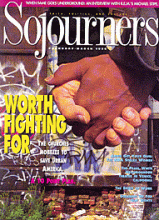Can a large-scale corps of nonviolent peacemakers be organized and readily mobilized to intervene in areas of intense conflict? And if so, what should it look like? Not easy questions, yet many people are seriously asking them. Peace movement veterans, United Nations organization heads, institutional church leaders, and even members of the military are becoming increasingly convinced that a viable alternative to military intervention needs to be created.
So when nearly 200 people (almost four times the anticipated crowd) gathered in New York last November at "Seeds of Change: An International Consultation on a Global Peace Service," there was no shortage of ideas or enthusiasm.
The idea for the consultation was born when Bill Price of World Peacemakers joined Mary Evelyn Jegen from Pax Christi and Margareta Ingelstam from the Swedish Ecumenical Council's four-year venture "Toward a Global Peace Service." Through their research and exploration, they learned of others who were busy dreaming and crafting an analogous vision. Robert Muller of the University For Peace used the exact language of a "Global Peace Service" in his writings, and veteran activist Elise Boulding had been working on a similar concept.
Jean Martensen of the Evangelical Lutheran Church of America, upon learning of their work, immediately offered financial support to sponsor a conference. David Hartsough of Peaceworkers, who mailed his description of a possible international peacemaking team to 100 very receptive people last summer, learned of the Global Peace Service initiative and eagerly offered the extensive work he had already done toward the effort.
Throughout the three-day conference, discussions about a Global Peace Service's potential components and criteria were interspersed with stories of nonviolent intervention and peacemaking.
Read the Full Article
